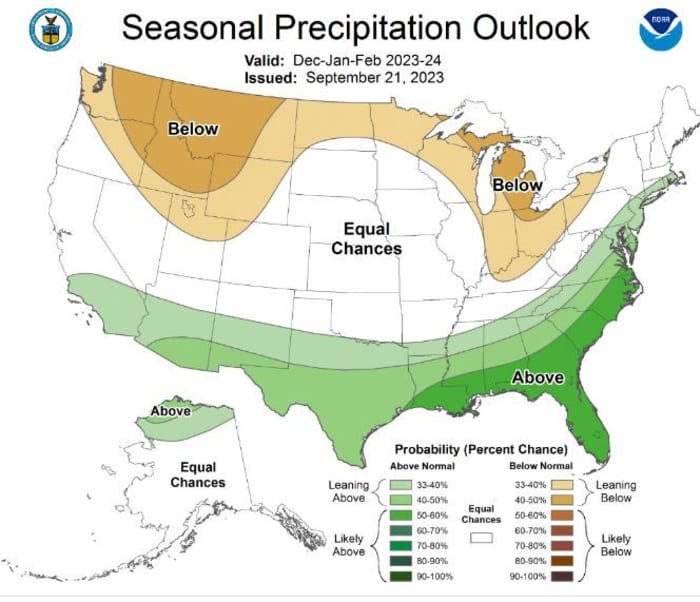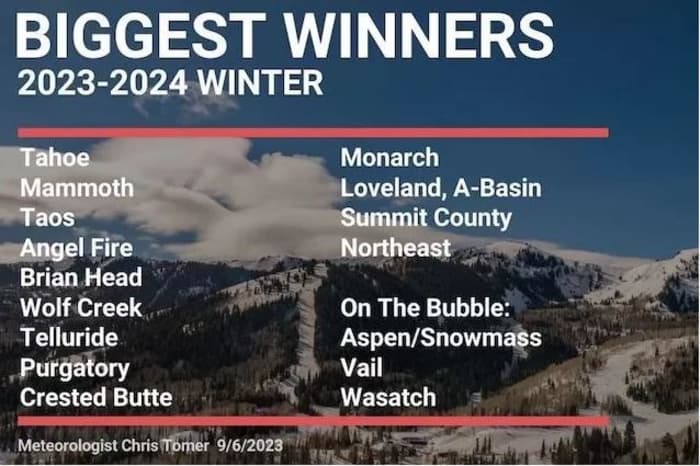[ad_1]
A great deal of the northern 50 % of the U.S. could see a milder winter season in coming months thanks to a combination of the hottest El Niño and ongoing patterns of above-common heat owed to human-designed local weather modify.
That’s especially legitimate of forecasts for Maine and pieces of Washington and Oregon.
The recurring weather phenomenon known as El Niño could indicate bigger rain amounts in Florida’s regular damp period, and continue to does not preclude a freeze that could place citrus crops at threat. The western Carolinas, as well, could see bigger-than-common snow.
The latest predictions from the Countrywide Oceanic and Atmospheric Administration could indicate small-time period relief for Americans who struggled by way of summer’s warmth extremes, but also pose a draw back for stores banking on a flurry of winter-garments and supplies purchases. The included precipitation, even so, details to a good deal of snowpack for skiing and snowboarding at well known web-sites.
In accordance to NOAA’s versions, there is a 95% prospect El Niño carries on by way of the wintertime. Generally, each time there is an El Niño sample in put, the Northern U.S. has warmer winters, NOAA claimed.

NOAA
In the meantime, throughout the South and for considerably of the Atlantic coastline into southern New England, the forecast phone calls for better prospects of a wetter-than-normal winter season, explained NOAA’s Weather Prediction Center.
Pieces of the Northwest, Mountain West and Great Lakes could see higher chances of underneath-ordinary precipitation and even though a much less-snowy wintertime can necessarily mean safer vacation, it can harm the precipitation construct relied on for a healthy crop-developing period afterwards in 2024.
What is an El Niño and what does it indicate for weather modify?
Because an El Niño, packing the opposite effect of a cooling La Niña, happens each several decades, men and women frequently surprise what the romantic relationship is between these weather conditions situations and extensive-running atmospheric warming recognised as local climate improve.
“Climate adjust will likely strengthen any ‘normal’ El Niño effects,” Dr. Stefan Schnitzer, professor of organic sciences Marquette University, told MarketWatch. “The greater worldwide temperatures will insert to the El Niño party, particularly in which rainfall improves.”
Human-manufactured local weather transform — brought on by the greenhouse fuel emissions place off by burning coal, oil
CL00,
and gasoline and blamed for accelerating historical climates shifts — has been warming the Earth’s temperature.
An El Niño is the somewhat normal sample in the tropical Pacific that brings hotter-than-typical sea-surface temperatures and influences climate. It emerged previously-than-expected in 2023.
NOAA in earlier reporting said that the continental U.S. had its ninth-warmest August on report. It also was the 15th-warmest summertime on document for the continental U.S. alone. Globally, August 2023 was the most popular on report. As a result of August, 2023 has been the 2nd-warmest calendar year on history throughout the world, NOAA reported.
Really don’t miss: It is formal: This summer time was the hottest on report
“Not only was past month the warmest August on record by really a whole lot, it was also the globe’s 45th-consecutive August and the 534th-consecutive month with temperatures previously mentioned the 20th-century average,” explained Dr. Sarah Kapnick, NOAA’s chief scientist.
“Global maritime heat waves and a developing El Niño are driving extra warming this calendar year, but as prolonged as emissions carry on driving a continuous march of track record warming, we hope more information to be damaged in the many years to come,” she said.
Browse: By now roasting in excessive heat? 2024 could be even hotter, NASA scientists warn.
What about El Niño and wintertime climate in the U.S. South and Midwest?
El Niño tends to convey wetter problems to the Southeast. Florida, in unique, experiences better-than-regular rainfall for the duration of El Niño winters. This can guide to localized flooding, specifically in lower-lying places and regions inclined to major downpours.
In accordance to the National Weather Provider in Tallahassee, Central Florida averages amongst 8 to 10 inches of rainfall throughout a common winter season. But all through El Niño winters, that rainfall overall rises to concerning 10 and 13 inches.
As for other sections of the South, El Niño commonly means much more precipitation, which in mountain regions, can suggest snow.
Mainly because the jet stream is displaced farther south, El Niño delivers frequent storms throughout these places, top to above-ordinary precipitation and under-normal temperatures. This mix commonly usually means additional snow in Western North Carolina. In point, some of the most significant seasonal snow totals have come all through El Niño winters. Most notably, in the winter of 1968-69, much more than 48 inches of snow fell in Asheville, N.C. And far more lately, the winter of 2009-10 was unusually snowy with a whopping 39 inches accumulating.
In the Midwest, El Niño ordinarily success in warmer and drier winters, that means fewer snow.
“During an El Niño winter, the polar jet stream shifts northward, lowering the exceptionally small temperatures that typically swing down into the Midwest, such as Wisconsin, Illinois, Michigan, and so on,” explained Marquette’s Schnitzer.
Schnitzer reminds that weather variability is constantly unpredictable. Forecasts use designs and historic designs to check out to offer an educated guess about the coming months.
“Occasionally we can get incredibly cold temperatures and snow in the course of an El Niño. It is dependent on what other climate units blow through the place,” he reported.

NOAA
What is El Niño’s influence on skiing and snowboarding?
Of training course the volume of precipitation can effect how considerably snowfall is predicted at higher elevations and what form of year big skiing and snowboarding locations can be expecting.
Throughout the early parts of the winter year, via the rest of 2023, knowledge implies a ordinary- to drier-than-normal period of time for most of the western U.S. As for the japanese U.S., predictions glimpse wetter than usual, states meteorologist Chris Tomer, in an outlook for the On the Snow website, with a prediction intently aligning with other gurus on the lookout at NOAA’s info.

Chris Tomer/On the Snow
By January, claims Tomer, the bulk of the El Niño-driven snowfall generally happens across sections of the West with a powerful subtropical jet.
“The sample suggests a better likelihood of atmospheric river (AR) functions. In the Northeast, normal- to previously mentioned-typical snowfall appears achievable. Be warned, nevertheless. “The pattern indicates that NorEaster storm devices are much more possible,” Tomer said.
To him, that suggests New England ski locations could see a significantly advantageous snowy winter season, which would be a welcome snapback from previous season’s winter season on the East Coastline.
Many Colorado ski locations, which include Summit County resorts, Loveland, Telluride and Arapahoe Basin, also stand to be amongst the biggest snow “winners,” says Tomer. He’s also upbeat for accumulation for New Mexico ski regions and California ski areas in the Sierras.
“El Niño traditionally does not favor any certain end result for Wasatch, Aspen Snowmass and Vail [in Colorado],” he extra. “However, if the Modoki contribution [when the warming is generated in a different part of the Pacific Ocean] to this El Niño increases, then all of these resorts could tilt a tiny bigger to 105% to 110% of ordinary wintertime snowfall.”
[ad_2]
Source hyperlink

